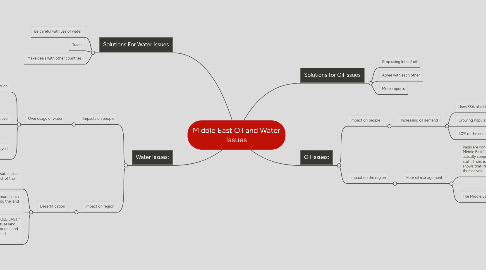
1. Solutions For Water Issues
1.1. Be careful with use of water
1.2. Trade
1.3. Make deals with other countries
2. Water Issues:
2.1. Impacts on people
2.1.1. Over usage of water
2.1.1.1. People irragate their plants too much
2.1.1.1.1. According to the text, "Desalination plants are an overuse of water resources in the Middle East. Seventy percent of desalination plants in the world are located in this area, found mostly in Saudi Arabia, the United Arab Emirates, Kuwait, and Bahrain."
2.1.1.2. Water Shortage for people's use
2.1.1.2.1. According to the text, " Agriculture uses 85 percent of water in this region. It is common to misuse land by heavy irrigation in the Middle East." So, because people irrigate too much, they don't have much water left in order to do things such as showering, and washing dishes.
2.1.1.3. Producing foods are destroyed by desertification.
2.1.1.3.1. According to the text, "The Middle East requires water resources and suitable land for agriculture. Much of the land that is available for producing food is destroyed by increasing desertification." This means that in the future, most of the land in the Middle East will be destroyed by desertification, and produce won't be able to survive, leaving many farmers with no jobs.
2.2. Impact on region
2.2.1. Desertification
2.2.1.1. Countries are not getting enough water, since irrigation and agriculture use up 85% of the countries' water supply.
2.2.1.1.1. Droughts
2.2.1.2. It is making the climate more harsh, since droughts are making the land dry.
2.2.1.3. Droughts change the landscape. According to "WATER IN CRISIS - MIDDLE EAST," "Agriculture uses 85 percent of water in this region. It is common to misuse land by heavy irrigation in the Middle East. In the area droughts are more frequent, and contribute to the changing landscape." This shows that desertification and droughts can change the land.
3. Solutions for Oil issues
3.1. Stop using lots of oil
3.2. Agree with each other
3.3. More imports
4. Oil Issues:
4.1. Impact on people
4.1.1. Increasing oil demand
4.1.1.1. Uses 33% of oil it produces
4.1.1.2. Growing Population
4.1.1.3. 40% of the energy
4.2. Impact on the region
4.2.1. Poor oil management
4.2.1.1. Iraqis are conducting war with themselves. According to "The Haves and Have-Nots: Oil in the Middle East," "Nor is this the oiliest part of Iraq. That lies in the deserts to the south where it actually seeps from the ground. In fact the whole of Iraq sits atop seams and pockets of the sticky stuff. There is plenty to go around, if only the Iraqis could agree to stop shooting each other. This shows that Iraq, at the time, can not share their oil because they are conducting war with themselves.
4.2.1.2. The Middle East isn't evenly sharing their oil
4.2.1.2.1. Countries are richer than others. According to "The Haves and Have-Nots: Oil in the Middle East," "Just eight Arab countries have actually grown rich from energy exports, though some of them spectacularly so: in the tiny emirate of Qatar some 14% of households are dollar millionaires, a higher proportion than in any other country in the world. " This shows that countries aren't willing to share because they are too greedy.

